Eggplants: How to Grow and How to Cook These Vegetables
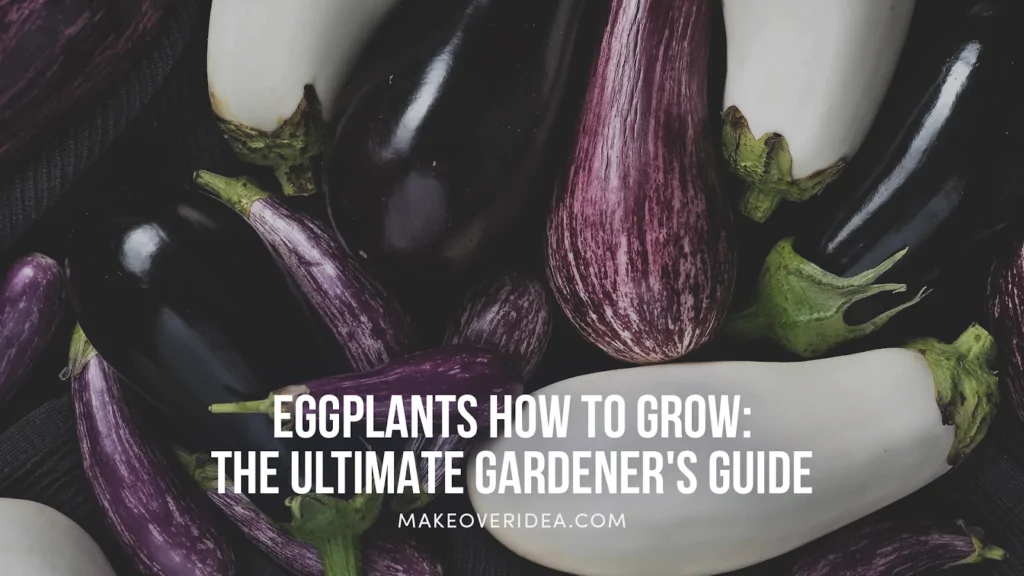
Do you like the taste of eggplants? Secrets of how to grow, harvest, and cook these healthy vegetables are revealed below: we’ll guide you through the process step by step.
Getting Started with Eggplants
There are several cultivars of eggplants, all of which are high in fiber and low in calories.
What are Eggplants?
Eggplants, also known as aubergines, are a popular vegetable belonging to the nightshade family, which also includes tomatoes, peppers, and potatoes. Originating in India, they have been cultivated for thousands of years and are now grown worldwide, with various varieties available.
Varieties and Types

The more popular types include the large, dark purple “Black Beauty,” the slender and tender “Japanese” eggplant, the small, round “Indian” eggplant, and the elongated “Chinese” eggplant. When selecting a variety to grow, consider factors such as your local climate, the size of your garden, and your culinary preferences.
Nutritional Value and Health Benefits
Eggplants are a low-calorie food, high in fiber, and packed with essential nutrients like vitamins C, K, and B6, as well as potassium, magnesium, and manganese. They also contain antioxidants, such as nasunin, which has been linked to improved brain function and heart health. Including these vegetables in your diet may help with weight management, lowering cholesterol levels, and reducing the risk of chronic diseases.
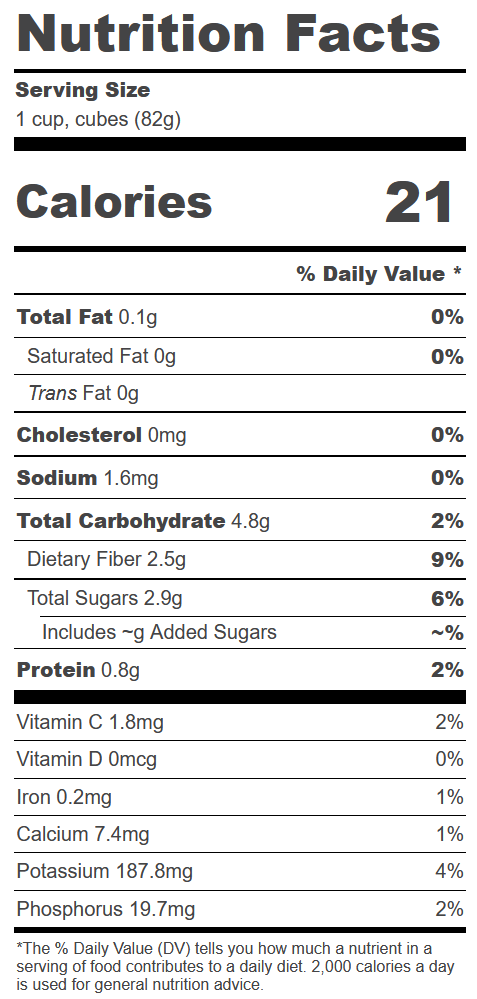
Ideal Growing Conditions
To grow healthy, thriving eggplants, it’s crucial to provide the right growing conditions.
Climate and Temperature
These vegetables are a warm-season crop, requiring plenty of sunlight and warm temperatures. They thrive in USDA hardiness zones 4 through 10, with an ideal temperature range of 70°F to 85°F (21°C to 29°C).
Temperatures below 50°F (10°C) can stunt growth and cause fruit drop; take this into consideration if you are planning to grow eggplants. The growing season of these vegetables is about 5-6 months long. Keep in mind that even during warm months you need to protect your vegetables from cold snaps.
Soil Requirements
Eggplants prefer well-draining soil with a pH level between 6.0 and 6.8. To ensure optimal growth, amend your soil with plenty of organic matter, such as compost or well-rotted manure, before planting. This will improve soil structure, provide essential nutrients, and promote healthy root development.
Planting and Nurturing Eggplants
Let’s get through the whole process step by step.
Starting from Seeds
Growing these vegetables from seeds allows you to choose from a wider variety of cultivars, and it’s a cost-effective way to start your eggplant garden.
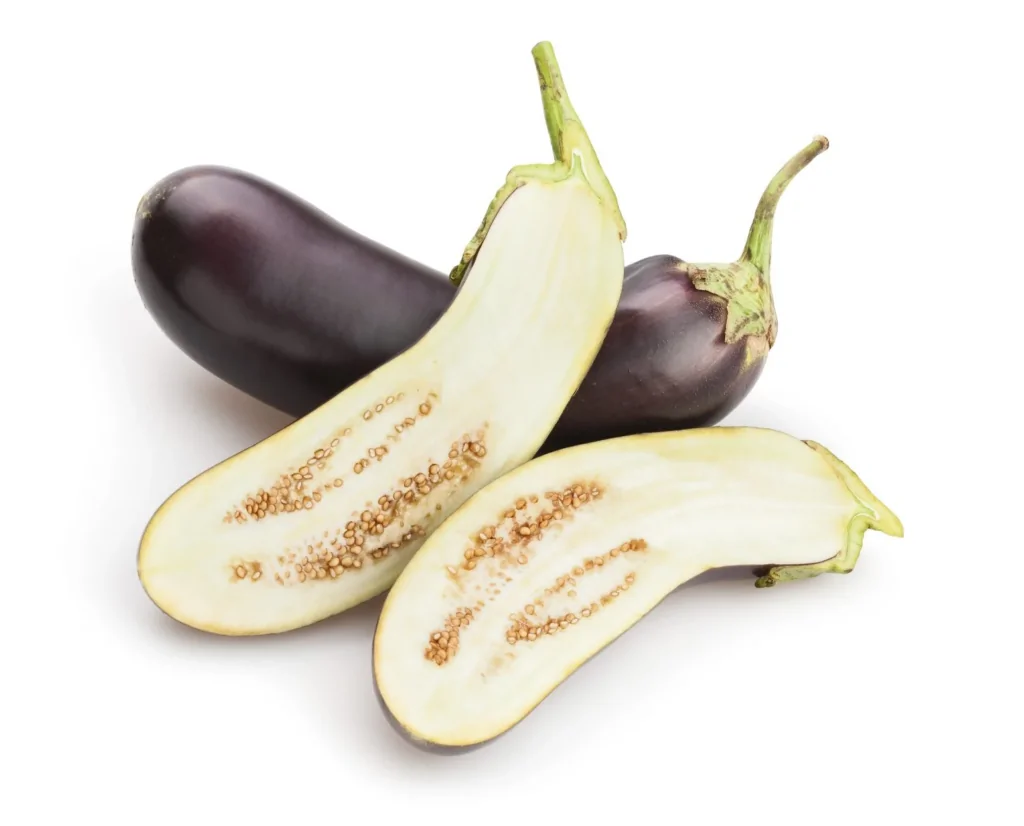
Indoor Seed Starting
Begin by sowing eggplant seeds indoors 6-8 weeks before your area’s average last frost date. Fill seed trays or small pots with a seed-starting mix and plant the seeds about ¼ inch deep. Keep the soil consistently moist and maintain a temperature of 70°F to 85°F (21°C to 29°C) for successful germination. Seedlings should emerge within 7-14 days. Provide plenty of light by placing the seedlings near a sunny window or under grow lights for 12-14 hours per day.
Transplanting Seedlings
Once nighttime temperatures consistently stay above 50°F (10°C) and the seedlings have developed at least two sets of true leaves, they’re ready to be transplanted outdoors. Harden off the seedlings by gradually exposing them to outdoor conditions over a week to 10 days. Space the plants 18-24 inches apart in rows 30-36 inches apart. Make sure the soil is well-draining and rich in organic matter, and choose a location that receives at least 6-8 hours of sunlight per day.
Caring for Your Eggplants
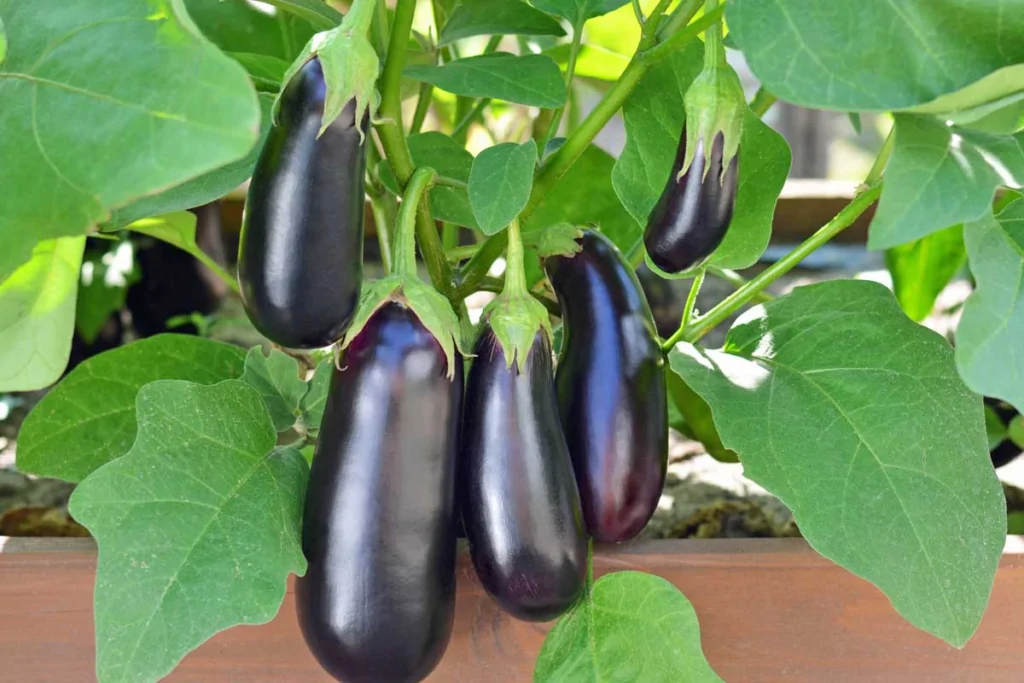
To ensure a bountiful harvest, it’s essential to provide your vegetables with proper care throughout the growing season.
Watering and Fertilizing
Eggplants require consistent moisture, especially during fruit development. Water your plants deeply and evenly, aiming for 1-2 inches of water per week. Use drip irrigation or water at the base of the plant to prevent water from splashing on the leaves, which can encourage disease.
Feed your vegetables with a balanced fertilizer every 4-6 weeks throughout the growing season. Alternatively, you can use compost tea or slow-release organic fertilizer to provide the necessary nutrients.
Pruning and Staking
Eggplants benefit from pruning and staking to improve airflow, support heavy fruit, and encourage a more significant harvest. Remove the lower leaves and any small, underdeveloped fruits to direct the plant’s energy into producing larger, healthier fruits.
Staking your eggplants can prevent branches from breaking under the weight of the fruit. Use stakes, cages, or trellises to support your plants, and tie the main stem and branches to the stakes using soft twine or cloth strips. Be gentle when tying the plants to avoid damaging the stems.
Pest and Disease Management
To learn how to grow eggplants in a garden, you also need to get familiar with preventing and controlling pests and diseases. Here are the most common issues and proactive measures you need to take to ensure a thriving harvest.
Common Eggplant Pests
Various pests can affect eggplants, including aphids, flea beetles, and spider mites. These pests can weaken your plants and reduce your harvest.

- Aphids: Tiny green or black insects that cluster on the undersides of leaves. They suck sap from the plants, causing leaves to curl and turn yellow. Control aphids by releasing beneficial insects like ladybugs or use insecticidal soap or neem oil to combat infestations.
- Flea beetles: Small, shiny black or brown beetles that jump when disturbed. They chew small holes in the leaves, potentially stunting plant growth. Apply diatomaceous earth, use row covers, or spray with a pyrethrin-based insecticide to control flea beetles.
- Spider mites: Tiny, spider-like creatures that create webbing on the undersides of leaves. They cause stippling and yellowing of the foliage. Introduce predatory mites or use insecticidal soap or neem oil to control spider mites.
Preventing and Treating Diseases
Eggplants can also fall victim to fungal and bacterial diseases. Prevention and early intervention are crucial for successful disease management.
Fungal and Bacterial Diseases
- Verticillium wilt: A soil-borne fungal disease that causes yellowing and wilting of leaves, often leading to plant death. Prevent verticillium wilt by rotating crops, choosing resistant varieties, and avoiding overwatering.
- Bacterial wilt: A bacterial disease that results in wilted and yellowed leaves, followed by plant collapse. Control bacterial wilt by removing and destroying infected plants, using disease-free transplants, and practicing crop rotation.
Organic and Chemical Treatments
When faced with persistent disease issues, you may need to resort to organic or chemical treatments:
- Organic treatments: Copper-based fungicides and bactericides can help control fungal and bacterial diseases. Apply these products according to the label directions and follow any necessary precautions.
- Chemical treatments: Synthetic fungicides and bactericides can also be effective in controlling diseases. However, use them judiciously and follow the manufacturer’s instructions to minimize any potential harm to the environment or beneficial organisms.
Harvesting and Enjoying Your Eggplants
Understanding when and how to harvest, as well as how to store and cook your eggplants, will ensure you make the most of your bountiful crop.
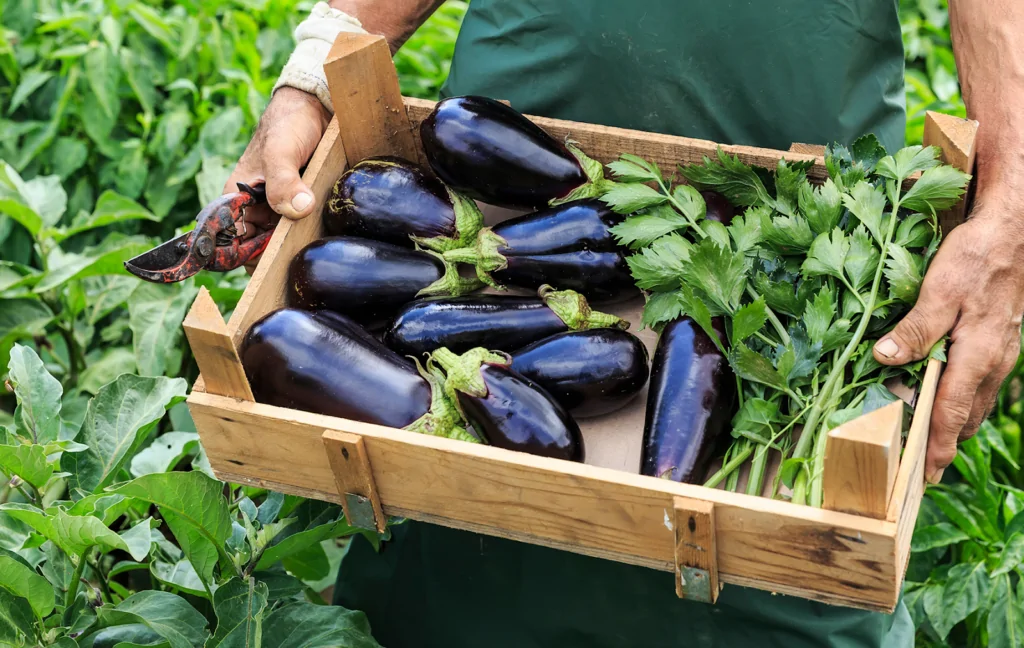
Knowing When to Harvest
Timing is crucial when it comes to harvesting these vegetables. Picking them at the right moment ensures the best flavor and texture.
Signs of Ripeness
- Size: Depending on the variety, eggplants should be harvested when they reach the expected mature size.
- Color: The skin should be glossy, and the color should be deep and uniform. Dull or wrinkled skin can indicate overripeness.
- Firmness: Gently press the eggplant with your thumb; a ripe eggplant will be firm but slightly give under pressure.
Harvesting Techniques
- Use clean, sharp pruning shears or scissors to cut the eggplant from the plant, leaving a short stem attached.
- Be gentle when handling the fruits, as they can bruise easily.
- Regular harvesting encourages the plant to produce more fruits, so keep an eye on your vegetables throughout the season.
Eggplants: How to Cook and Store
Once harvested, eggplants can be stored and used in various culinary dishes.
Storage Tips
Store eggplants in a cool, dark place (50-55°F) with good air circulation, such as a basement or pantry.
Avoid refrigerating eggplants, as temperatures below 50°F can cause chilling injury, leading to browning and off-flavors.
These vegetables are sensitive to ethylene gas, so keep them away from fruits that produce this gas, like apples and bananas.
Use them within a week of harvesting for optimal quality.
Delicious Eggplant Recipes

Eggplants are incredibly versatile and can be used in various cuisines:
- Classic eggplant Parmesan: Breaded, fried eggplant slices layered with marinara sauce and mozzarella cheese, then baked to perfection.
- Grilled eggplant: Sliced eggplants marinated in olive oil, garlic, and herbs, then grilled for a smoky, tender side dish.
- Baba ganoush: A creamy Middle Eastern dip made from roasted eggplants, tahini, lemon juice, garlic, and spices.
- Ratatouille: A flavorful French vegetable stew featuring eggplants, tomatoes, zucchini, and bell peppers, seasoned with herbs.
Frequently Asked Questions
The time it takes to grow eggplants varies depending on the variety and growing conditions. Generally, it takes around 100-120 days, from planting seeds indoors to harvesting ripe fruits. Transplanting seedlings outdoors should be done after the last frost and when soil temperatures reach at least 60°F.
Eggplant and aubergine are simply different names for the same plant, Solanum melongena. The term “eggplant” is more commonly used in North America, while “aubergine” is more popular in Europe and other English-speaking countries.
Colloquially known as ‘long egplants’, the Japanese or Chinese varieties only require minor adjustments. If you want to know how to grow Japanese eggplants, simply follow the same basic growing guidelines outlined in this article. However, you may need to provide more space between plants and additional support for the fruits.
To prevent pests and diseases, practice good garden hygiene by removing plant debris and weeds, as well as using clean tools. Crop rotation, companion planting, and regular monitoring can also help keep pests and diseases at bay. If a problem arises, use organic or chemical treatments as necessary, following the manufacturer’s instructions.
Yes, you can grow these vegetables from seeds. Start seeds indoors 8-10 weeks before the last frost date in your area. Transplant the seedlings outdoors when the soil temperature is at least 60°F and all risk of frost has passed.
Conclusion
Time to enjoy your very own eggplants! Techniques of how to grow, protect, and harvest these vegetables are not at all difficult: follow the guidelines and tips provided in this article, and you’ll be well on your way to enjoying a bountiful harvest of delicious, homegrown vegetables. Happy gardening!